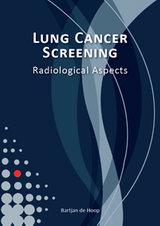Lung Cancer Screening: Radiological Aspects
B. de Hoop
- Promotor: W. Prokop and J. Lammers
- Copromotor: H. Gietema and B. van Ginneken
- Graduation year: 2010
- Utrecht University
Abstract
Multiple lung cancer screening studies are currently being conducted to study whether lung cancer screening with Computed Tomography (CT) can decrease lung cancer mortality. This thesis addresses radiological methods that can increase efficacy and efficiency of lung cancer screening. Different imaging modalities were tested. Compared to CT, chest radiography (CXR) has the advantage of low costs, low radiation and easy accessibility. Digitalization of CXR has improved visualization of pulmonary structures. In direct comparison however, digital CXR proved far less efficient than low-dose CT for the purpose of lung cancer screening. The radiologists primarily failed to recognize, rather than overlook, malignancies that were being missed on CXR. Less than 2% of nodules that are found during CT screening prove malignant. Nodules can be differentiated based on growth rate or morphology. Growth rates are expressed in volume doubling times. Reproducibility of measurements performed by multiple volumetry software packages was tested. Reproducibility of volumetry proved far better than measurements of nodule diameter. The measurement of nodule volume is insufficient for growth measurements in ground glass nodules (GGNs), as these lesions can also grow by appearance or increase of a solid component. Measurement of GGN mass is introduced as a new method and proved to have superior reproducibility compared to volumetry in these lesions. It may help to detect growth in GGNs earlier. Morphology can also be used to differentiate nodules. We found that fissure attachment in nodules with a smooth margin indicates benignancy. Twenty percent of all screening-detected nodules showed these characteristics. None of them proved malignant during follow-up. The combination of ground glass appearance and growth proved a strong sign of malignancy, but these GGNs tend to grow very slow. Follow-up may be a valid option to monitor changes in such lesions, but resection should be considered in any growing GGN. The mortality reduction intended by lung cancer screening could possibly be increased when screening is expanded to other smoking-induced diseases like COPD. This thesis addresses the automatic detection and quantification of pulmonary emphysema in smokers. A follow-up study was performed. A greater degree of emphysema was associated with stronger decline of lung function over time. This suggests that quantification of CT-detected emphysema may aid to indentify non-obstructed individuals who will develop COPD.
